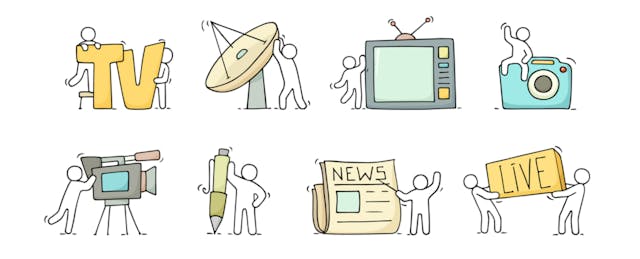When was the last time you wrote an essay? When was the last time you read one other than for grading?
Now think about the frequency with which you read online articles, blogs, social media posts or listen to podcasts that inspire you or provide new information and perspectives. When did you last watch YouTube to figure out how to do something complicated, from cross stitch to car repair?
If you’re like me, you’ve done much of your reading and learning through some kind of digital publishing platform—because it’s easy, accessible and often free. Whether text, video or something else entirely, each of these mediums encompasses a form of writing.
The ubiquity and impact of digital writing can’t be ignored. Nearly 70% of Americans get some of their news from social media; world views—impacting presidential campaigns and more—are shaped by these platforms. Yet most high school and middle school students are illiterate when it comes to online texts, and can’t discern real information from fake news.
We can not omit digital literacy from our curriculum.
In addition learning how to read and consume digital texts, our students must know how to author and publish in the digital realm. What’s at stake is our students’ ability to become thoughtful citizens, and their ability to write and publish perspectives and information that will be crucial for their career success. The National Association for Media Literacy in Education has defined media literacy as being able to analyze digital texts as well as create them.
Redefining writing
We need to reframe our conversation about writing from one based on polarities of analog versus digital to one about purpose, passion and relevance. Just as the technological revolution of the printing press democratized the authorship and distribution of books, so too does social media and the internet allow for more voices to be heard and for a wide variety of authors—including our students—to connect with audiences around the world.
Increasingly, writing doesn’t mean a five paragraph essay written by hand. And although the medium used to write can take many forms other than words on paper, the foundations of good writing are the same in any platform—critical thinking and analysis, structure, voice, tone, and audience.
Like its analog predecessors, digital writing can be used in formative and summative assessments, non-fiction writing, and for creative self-expression. Authoring with multimedia such as video, photography and sound introduces an entirely new set of grammar and vocabulary, not just a new set of tools. Students become savvy consumers of information and ideas when they understand how the messages they encounter are created.
How to help your students evolve from analog to digital writers
Start with simple assignments that are an easy transition from what you and your students are already familiar with. Try blogging, then build to more complex projects like podcasting or video storytelling. In addition to concentrating on the ideas and the writing itself, try to create situations where the students’ writing takes advantage of the medium and the connectedness of the internet.
Some criteria I use to develop assignments include:
- student agency
- engagement and passion
- audience impact beyond the classroom
- authoring skills and experiences needed for success outside of academia
- collaboration and connectivity with other authors and audience members
- experiences authoring in a variety of media other than text
When we develop our writing assignments, we must ultimately come back to one main concern: purpose. Why are we giving specific types of writing assignments and how do they help our students convey their ideas in ways that resonate with their audience?
Social media: The haiku of digital writing
A great way to introduce students to online publishing is to use social media. It’s a familiar, relevant publishing platform and allows for quick access to a global audience. The brevity of the format (Twitter’s 140 characters, for instance) forces students to synthesize their ideas down to the essential story elements.
For example, Larry Reiff, a high school English teacher in New York, uses Twitter to teach his students about Shakespeare by having them tweet in the voice of characters. Students learn the literature through public performance, understand social media tools, and become better writers.
“Knowing that the whole world may see their work forces students to step up,” says Reiff. “They proofread a little bit more closely. They double check the punctuation. I soon as the students begin to post their work online, I noticed a gradual improvement in their writing.”
Journalism students use Twitter, Instagram and Snapchat to publish news, becoming familiar with the platform’s immediacy and how to connect with audiences through tagging and mentions. Social media relies heavily on an awareness of voice and audience. Each social media app has a slightly different demographic, and the nature of a scrolling feed means that publishing content demands an awareness of timing and when audience members will see posts.
Blogging: The online magazine
An online publication can have one or many writers, developing assignments around student-selected themes. Digital ‘zines can include expository and persuasive writing, each involving research, interviews, and analysis. Narrative writing is a great way to integrate creative writing in the form of short story or poetry, and is the next step in the publication of literary magazines.
Because blog entries are published on websites, they can easily incorporate photography, infographics, and embedded video. This is a great way to scaffold all elements of digital literacy, as student assignments become increasingly complex and build digital literacy skills over the course of the school year.
The best part about digital writing is that it is also its own portfolio. Because student-published work lives online—not in a file cabinet—it is easily collected into a resume with hyperlinks, or a Storify best-of collection of social media posts. Resumes are their own type of story, carefully curated for each employer (target audience) who is looking for a specific set of skills.

A picture is worth 1000 words: Video and multimedia writing
While scripts and interview questions form the foundation for multimedia projects, the real communication going on here is with the images themselves. Visual literacy, the understanding of and use of images to convey information, is where writing is headed.
Facebook predicts that in a few years the majority of posts to its site will be video. What’s more, the presence of photos and video on social media posts increases audience interaction significantly. If one of our main purposes for writing is to have an impact on an audience, then this is going to be the best way to go.
Podcasts and explainer videos have taken off in popularity because they’re relevant, packed with information, and are easy for a global audience to access. Explainer videos also let you assess student knowledge in a way that is dynamic and actually useful for an audience beyond the classroom. Rather than an essay or multiple choice test, students create videos to demonstrate their knowledge. After all, the best way to learn is to teach.
With a grammar all its own, video is so much more than recorded plays. Using visual evidence in documentaries and journalism is the ultimate skill for learning expository and persuasive writing. It can also be used to teach a variety of literary devices through creative visual storytelling.

As teachers, our goal is to instill a love for writing in our students, to get them to write in all of its forms, and prepare them to communicate ideas effectively to an audience in the real world. When we teach our students to write for digital media, it sends a message that our assignments are relevant, exciting and important.


